

Steps for Applying Design Thinking to Build and Evolve Schools. High School design team members check out ideas written on post-it notes during a brainstorming session.
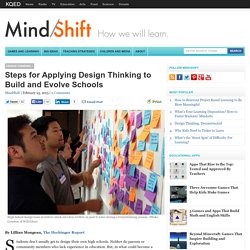
(Photo: Courtesy of Will Eden) By Lillian Mongeau, The Hechinger Report Students don’t usually get to design their own high schools. Neither do parents or community members who lack experience in education. Kids Solve The Most Pressing Urban Problems With Designs You'd Never Think Up. Ask a 10-year-old how to solve the problem of cleaning up trash, and you might end up with a concept like the "De-Waster 5000," a helicopter that scoops plastic out of landfills and the ocean—and then uses a solar-powered flamethrower to melt the trash into beds for homeless people.

In other words, you'll get something that probably wouldn't occur to an adult designer. The De-Waster was one of the prototypes created in the Global Childrens' Designathon on November 15, which invited kids in five cities to spend a day designing solutions to improve food, waste, or mobility issues in their hometowns. For the designers behind the workshop, the event was a way to introduce children to skills they probably aren't learning in the classroom. "A big impetus for the project is the way children learn or don't learn," says Emer Beamer, founder of Unexpect, a Dutch agency that focuses on teaching children how to use design to tackle global challenges. Shape - A Film About Design. Design Thinking: Lessons for the Classroom. The Design Thinking Process While design thinking has its roots in the innovation/design sector, the process itself can be used anywhere.
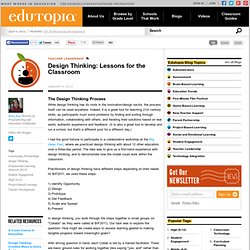
Indeed, it is a great tool for teaching 21st century skills, as participants must solve problems by finding and sorting through information, collaborating with others, and iterating their solutions based on real world, authentic experience and feedback. Why Every School Must Teach Designing. Do something for me. Stand in front of the mirror and just look at your physical beauty. Can you imagine the immense amount of thought that would have gone into designing something as complex as a human being? Design Thinking. WHAT IS DESIGN THINKING?
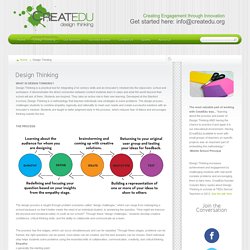
Design Thinking is a practical tool for integrating 21st century skills and an innovator’s mindset into the classroom, school and workplace. It demonstrates the direct connection between content students learn in class and what the world beyond their school will ask of them. Students are inspired. They take an active role in their own learning. Developed at the Stanford d.school, Design Thinking is a methodology that teaches individuals new strategies to solve problems. The design process is taught through problem scenarios called “design challenges,” which can range from redesigning a school backpack so that it better meets the need of an individual student, to answering the question, “How might we improve the physical and emotional safety of youth at our school?”
The process has five stages, which can occur simultaneously and can be repeated. HOW IS IT DIFFERENT FROM TRADITIONAL EDUCATION? Rethinking Education with Design Thinking - Point of View - February 2014. Peter Pfau At Brightworks, the design thinking school in San Francisco, students create prototypes to test their ideas relating to the project of the day.

Courtesy Brightworks Stop. Put down your pencils and take a break from the angst over endless test preparations to consider how design thinking may help schools shed the “rat race” of teaching to the tests. Standardized testing has manifested a pressure cooker atmosphere with a learn-memorize-test approach. 45 Design Thinking Resources For Educators. 45 Design Thinking Resources For Educators Imagine a world where digital learning platforms help adult learners succeed through college completion; where a network of schools offers international-quality education, affordable tuition, and serves hundreds of thousands of children in economically disadvantaged countries; where we engage parents in understanding national trends and topics in education; where a comprehensive learning environment seamlessly connects the classroom with the opportunities of the digital world for young students; and where system-level solutions help more students gain access to college.

Educators across the world have been using design thinking to create such a world. Design thinking consists of four key elements: Defining the Problem, Creating and Considering Multiple Options, Refining Selected Directions, and Executing the Best Plan of Action. An early example of design thinking would have been Edison’s invention of the light bulb. Design Thinking: Lessons for the Classroom. Design Schools: Please Start Teaching Design Again. It’s that time of year when Adaptive Path wades through stacks of design school students’ resumes, looking for summer interns and potential hires.
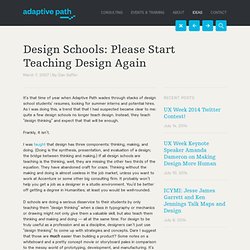
As I was doing this, a trend that that I had suspected became clear to me: quite a few design schools no longer teach design. Instead, they teach “design thinking” and expect that that will be enough. Frankly, it isn’t. I was taught that design has three components: thinking, making, and doing. (Doing is the synthesis, presentation, and evaluation of a design; the bridge between thinking and making.) A Design Lens on Education. “Education provides the foundation of our global possibilities.

We design this well, and the whole world changes.” I agree wholeheartedly with this statement from Sandy Speicher, one of the few people I know who is well qualified to have a perspective on both design and education. Urban Preschool – Art and Education » Why Teach Design Thinking? Every now and then I have some time to browse through the numerous links that I have saved in my “play+design” folder.
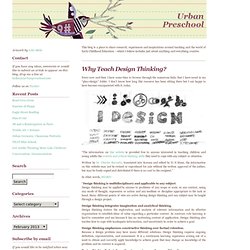
I don’t know how long this resource has been sitting there but I am happy to have become reacquainted with it, today. “The information on this website is provided free to anyone interested in teaching children and young adults the creative and critical thinking skills they need to cope with any subject or situation. Written by Dr. Charles Burnette, translated into Korean and edited by Yi Ji Hyun, the information on this website may not be revised or reproduced for sale without the written approval of the author, but may be freely copied and distributed if there is no cost to the recipient.” In other words, SHARE! How To Use Design Thinking To Teach Problem Solving. By Suzie Boss on April 10, 2013 As a strategy for problem solving, design thinking is quickly gaining a foothold in a variety of K-12 settings.

IDESiGN_Why Teach Design Thinking? Teaching Design Thinking. Teaching Kids Design Thinking, So They Can Solve The World's Biggest Problems. You cannot solve a problem with the same mind that created it. ? Albert Einstein Assessment The test scores are out again. And once again, American kids aren't doing so well. You can choose any of the international standardized tests and on average, American children will always be stuck in the middle, compared with their peers in other countries. A Vision We all recognize a need for massive change in American education, but is our ultimate goal to outrank other countries in assessment tests and to beat the Chinese in math scores?
We need new minds equipped with new ways of thinking. Our world desperately needs leadership in achieving sustainable social justice, not simply learning the answer to a test question. Future generations will be called to solve some of the most challenging problems ever created and faced by man. Welcome to the Virtual Crash Course in Design Thinking. Welcome to the d.school’s Virtual Crash Course resource page! We know not everyone can make a trip to the d.school to experience how we teach design thinking. So, we created this online version of one of our most frequently sought after learning tools.
Using the video, handouts, and facilitation tips below, we will take you step by step through the process of hosting or participating in a 90 minute design challenge. If you choose to participate, in 90 minutes you will be taken through a full design cycle by participating in The Gift-Giving Project. This is a fast-paced project where participants pair up to interview each other, identify real needs, and develop a solution to “redesign the gift-giving experience” for their partner.
Through this experience we hope you will take away some of the basic principles of Design Thinking and start to adapt them into your personal and professional routines. Below, you will find three sections: Gear Up! Design Thinking - Bootcamp I by Jan Schmiedgen.